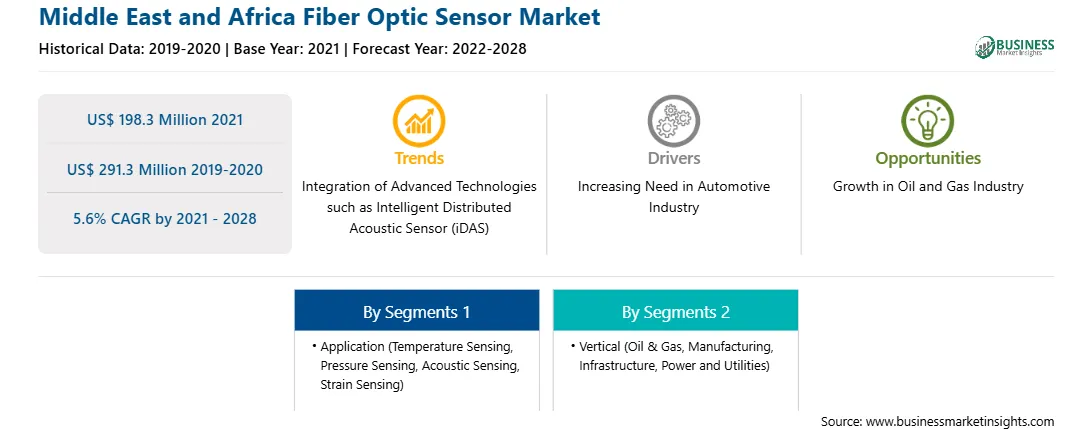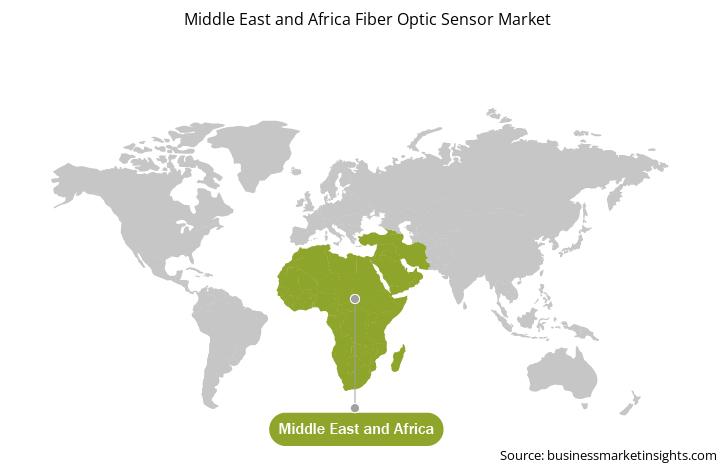This research report on the “Fiber optic sensor Market” provides a holistic view of the market size across major regions. The report further elucidates the key driving factors, restraints, growth opportunities, and future trends pertaining to the market growth.
Moreover, the surging applications in oil & gas sector is expected to bolster the market growth during the forecast period.
The demand for fiber optic sensors has weakened since the eruption of COVID-19 in MEA countries. This has resulted in a loss of business among the fiber optic sensors manufacturers offering their products to various industries in the region. Countries with higher manufacturing units such as Turkey, Israel, and South Africa, among others have witnessed critical scenarios in procuring various electronics and semiconductor products including sensors which showcased fall in MEA fiber optic sensors market in the region. The oil & gas activity in the region is among the rapidly growing industry. The UAE, Saudi Arabia, and Qatar represent the forerunners in the oil & gas industry globally. The outbreak of COVID-19 virus had paused several oil & gas and construction activities in the countries mentioned above, and some of the projects are still likely to remain halted. This parameter is among the key factors that have negatively impacted the above mentioned industry and subsequently impaired the fiber optic sensors market.

Strategic insights for the Middle East and Africa Fiber Optic Sensor provides data-driven analysis of the industry landscape, including current trends, key players, and regional nuances. These insights offer actionable recommendations, enabling readers to differentiate themselves from competitors by identifying untapped segments or developing unique value propositions. Leveraging data analytics, these insights help industry players anticipate the market shifts, whether investors, manufacturers, or other stakeholders. A future-oriented perspective is essential, helping stakeholders anticipate market shifts and position themselves for long-term success in this dynamic region. Ultimately, effective strategic insights empower readers to make informed decisions that drive profitability and achieve their business objectives within the market.

| Report Attribute | Details |
|---|---|
| Market size in 2021 | US$ 198.3 Million |
| Market Size by 2028 | US$ 291.3 Million |
| Global CAGR (2021 - 2028) | 5.6% |
| Historical Data | 2019-2020 |
| Forecast period | 2022-2028 |
| Segments Covered |
By Application
|
| Regions and Countries Covered | Middle East and Africa
|
| Market leaders and key company profiles |
The geographic scope of the Middle East and Africa Fiber Optic Sensor refers to the specific areas in which a business operates and competes. Understanding local distinctions, such as diverse consumer preferences (e.g., demand for specific plug types or battery backup durations), varying economic conditions, and regulatory environments, is crucial for tailoring strategies to specific markets. Businesses can expand their reach by identifying underserved areas or adapting their offerings to meet local demands. A clear market focus allows for more effective resource allocation, targeted marketing campaigns, and better positioning against local competitors, ultimately driving growth in those targeted areas.

The Middle East and Africa fiber optic sensor market is projected to reach US$ 291.3 million by 2028 from US$ 198.3 million in 2021; it is anticipated to grow at a CAGR of 5.6% from 2021 to 2028. Various governments are taking initiatives to propel the development of smart cities in their respective economies. In March 2021, Optromix, Inc. announced fiber optic sensors that can be installed as a component of smart transport. The company is engaged in providing intelligent traffic analysis and route planning services in large cities. These services are based on fiber optic solutions for the collection and processing of vehicle movement data. Thus, the growth in such efforts to develop smart cities are providing significant opportunities for the growth of the fiber optic sensor market players.
In terms of vertical, the oil & gas segment accounted for the largest share of the Middle East and Africa fiber optic sensor market in 2020. Further, based on application, the temperature sensing segment held the largest market share in 2020. The actual time monitoring of underground well conditions is becoming increasingly vital in the oil & gas vertical. To gain a comprehensive picture of underground conditions, operators are using downhole fiber-optic sensors to accurately measure parameters such as temperature and pressure along the length of the wellbore in real time. The useful information about well condition and operation obtained from the sensor data helps the well operators in fine tuning of conditions, thus achieving maximum production. The collection of fiber optic sensor data and analysis of the same reduce uncertainty, enabling better operational decisions that can significantly reduce environmental impact of operations, in addition to increasing well production. Moreover, these sensors are used to real-time leakage detection and predictive maintenance in the oil & gas plants. Such as, AFL provides optimized fiber optic cables for the oil & gas sector. Thus, with the increasing importance of fiber optic sensors in the oil & gas industry, the demand of these sensors is on rise, thus fuelling the market growth.
A few major primary and secondary sources referred to for preparing this report on the fiber optic sensor market in Middle East and Africa are company websites, annual reports, financial reports, national government documents, and statistical database, among others. Major companies listed in the report are Omnisens SA, Solifos AG, Baumer Holding AG, OMRON Corporation, SICK AG, and Yokogawa Electric Corporation.
By Vertical
By Application
By Country
The Middle East and Africa Fiber Optic Sensor Market is valued at US$ 198.3 Million in 2021, it is projected to reach US$ 291.3 Million by 2028.
As per our report Middle East and Africa Fiber Optic Sensor Market, the market size is valued at US$ 198.3 Million in 2021, projecting it to reach US$ 291.3 Million by 2028. This translates to a CAGR of approximately 5.6% during the forecast period.
The Middle East and Africa Fiber Optic Sensor Market report typically cover these key segments-
The historic period, base year, and forecast period can vary slightly depending on the specific market research report. However, for the Middle East and Africa Fiber Optic Sensor Market report:
The Middle East and Africa Fiber Optic Sensor Market is populated by several key players, each contributing to its growth and innovation. Some of the major players include:
The Middle East and Africa Fiber Optic Sensor Market report is valuable for diverse stakeholders, including:
Essentially, anyone involved in or considering involvement in the Middle East and Africa Fiber Optic Sensor Market value chain can benefit from the information contained in a comprehensive market report.